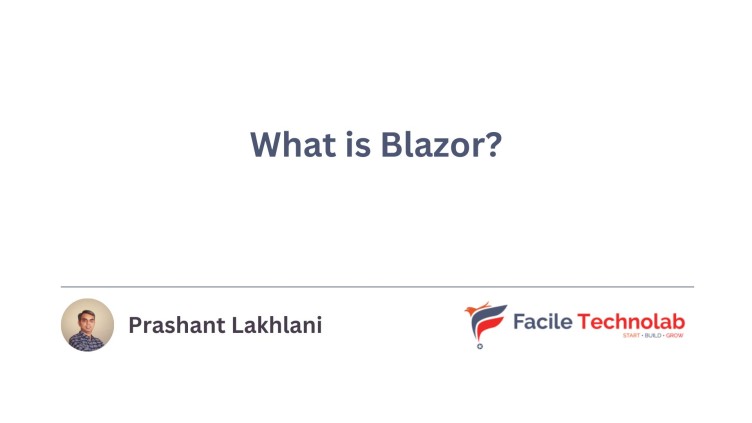Introduction to Blazor for Web Development
 Facile Technolab
Facile Technolab
In this article, I will delve into the intricacies of Blazor, exploring its various aspects and shedding light on its relevance in the realm of web development.
What is Blazor?
Blazor is a free and open-source web framework developed by Microsoft that enables developers to create web apps using c# and html. Blazor uses power of .NET and C# to build full stack web apps without writing a line of JavaScript.
A Brief History
Introduced by Microsoft, Blazor was an experimental project. Initially showcased in 2017, it has since evolved into a robust framework and finally released Blazor server version in 2019 and Blazor client-side (Blazor WebAssembly) version in 2020. Blazor's latest version is released with .NET 8 which brings in so many exciting features.
Applications Redefined: What Can You Build with Blazor?
Blazor isn't just a framework; it's a versatile tool for crafting a variety of applications. From interactive single-page applications (SPAs) to real-time collaborative tools, Blazor empowers developers to create solutions that seamlessly integrate into diverse business landscapes.
Blazor server vs WebAssembly:
Choosing between Blazor Server and Blazor WebAssembly involves a strategic decision based on specific project requirements. Blazor Server excels in scenarios where real-time updates and minimal client-side processing are paramount. With the server managing the application state, Blazor Server offers a responsive and seamless user experience.
Blazor Framework:
Learn Blazor, a cutting-edge framework by Microsoft, is revolutionizing web development by seamlessly blending C# and .NET capabilities into the client and server sides. Offering the flexibility of both server-based and client-side models, Blazor simplifies the creation of interactive and dynamic web applications. With its robust ecosystem and continuous support from Microsoft, developers can harness the power of Blazor to build modern, feature-rich applications, making it a versatile and forward-looking framework in the ever-evolving landscape of web development.
Blazor Desktop:
Blazor extends its transformative capabilities beyond web development to the realm of desktop applications with Blazor Desktop. Leveraging the power of .NET and C#, Blazor Desktop allows developers to craft high-performance, cross-platform desktop applications with the familiarity of Blazor components.
Blazor WebAssembly(Blazor WASM) Adoption:
WebAssembly, (sometimes called wasm) is the tech that makes Microsoft's client-side Blazor possible, as it's a low-level assembly-like language that serves as a compilation target for several programming languages, allowing them to be used in browser-based projects that heretofore primarily relied upon the ubiquitous, love-it-or-hate-it JavaScript.
What is blazor in .net:
Interested in learning .NET now, Blazor is the technology you can focus on while building web applications. The Blazor comes in two forms – the Blazor server and the Blazor web assembly. Let’s start with the Blazor.
Blazor is included as part of .NET 5.0. Thus, with Blazor on board, you have everything you need to develop a rich and modern web application. This article discusses how to get started with Blazor in .NET 5.0.
Comparative Analysis: Blazor vs. React
Blazor and React are open-source tools for building interactive single-page applications (SPAs). React is a Javascript library that was launched in 2013 by Facebook to enable developers to build intuitive interfaces and UI components.
Blazor on the other hand is a UI framework that was launched in 2018 by Microsoft. Unlike React, Blazor relies on C# and Razor syntax, instead of Javascript, to create reusable and intuitive user interfaces. Until Blazor’s invention, all major frontend frameworks were built on top of JavaScript, so Blazor has created a bit of a splash in the developer community.
Blazor Server vs. Blazor WebAssembly: Navigating the Choices
What is Blazor, we will compare Blazor Server vs Blazor WebAssembly and show some pros and cons.
Usually, while developing a web application, we create a server-side project using Java, .NET, Node.js, or some other framework or language. We want to use that server-side project to show some data in a browser by using a JavaScript framework like Angular, React, or Vue.js. And this is just fine, moreover, it is a great solution.
But, we can’t use the language we used for the server-side application in the client-side application. So, there is a fundamental disconnect between these two.
So, wouldn’t it be great if we could use the same language for the server and client-side applications and reuse our knowledge? Well, we believe it would. We can achieve that by using WebAssembly. It is a native part of all the major browsers and it allows us to reuse our code from the server-side applications.
Blazor Components: Building Blocks of Interactive UI
Blazor Components are the building blocks of any Blazor application. They're reusable pieces of UI written using C# and HTML that encapsulate the logic required for user interaction. These can include both static and dynamic elements.
For more insights, refer to the Blazor Components documentation on Microsoft Docs.
Blazor vs Razor: Unraveling the Confusion
With the release of .NET 6, and the hype-cycle around Blazor as a go-to solution for C# developers to write single-page web applications, the question comes up, “What is the difference between Blazor and Razor”?
Though Blazor and Razor are not directly comparable, as they represent two distinct capabilities, often the terms for Blazor components and Razor components are widely used interchangeably.
With this article, I will clear up the difference between Blazor vs Razor, as well as show you how to use each in Ignite UI for Blazor. You’ll also build a .NET 6 app, using the Card View component from Ignite UI, so you can get familiar with Blazor and Razor in a real application!
Microsoft's Commitment to Blazor(Microsoft Blazor): What the Future Holds
Blazor is a promising framework supported by Microsoft that allows for rich client-side interactivity using C# code, with options for web, mobile, and desktop applications, and it is important for C# developers to understand its benefits and consider its adoption.
Blazor in Desktop Development: Beyond the Browser
This model allows developers to build native mobile or desktop applications using a hybrid approach in which Razor components run directly in the .NET process instead of WebAssembly. This means that this approach doesn’t require WebAssembly to run the application.
Blazor JavaScript:
Blazor uses JavaScript to bootstrap the .NET runtime. It is able to use any JS library. C# code can call a JS function/API and JS code can call any C# method. This property of calling a JS method from C# code and vice versa is referred as JavaScript Interop. Blazor uses JavaScript Interop to handle DOM manipulation and browser API calls.
JavaScript Interop is the feature provided by WebAssembly, since Blazor runs on Mono and mono is compiled to WebAssembly. Hence, Blazor can also implement this feature.
Ready to unlock the full potential of Blazor for your web development projects? leveraging open source build successful projects faster and discover how we can elevate your digital landscape with cutting-edge solutions.
Frequently Asked Questions:
What is Blazor, and how does it fit into the world ofweb development?
Blazor is a modern web framework by Microsoft that allows developers to build interactive web applications using C# and .NET. It offers a unified approach, enabling code sharing between the client and server sides.
How does Blazor differ from traditional web development frameworks?
Unlike traditional frameworks, Blazor enables developers to write both client and server-side logic in C#, promoting code reuse and maintaining a consistent development experience.
What are the key components of Blazor that contribute to its versatility?
Blazor consists of two models—Blazor Server and Blazor WebAssembly. Blazor Server performs server-side rendering, while Blazor WebAssembly allows the execution of C# code directly in the browser.
How does Blazor enhance developer productivity in web application development?
Blazor simplifies the development process by leveraging the familiarity of C# and .NET, reducing the learning curve for developers and facilitating rapid application development.
Can Blazor be used for building both single-page applications (SPAs) and traditional multi-page applications?
Yes, Blazor supports the development of both SPAs and traditional multi-page applications, offering flexibility to cater to various project requirements.
What advantages does Blazor bring to developers in terms of code maintainability and organization?
Blazor promotes clean and organized code structures, as developers can use components to encapsulate UI elements and functionality, fostering modular and maintainable codebases.
How does Blazor contribute to a seamless development experience for .NET developers?
Blazor integrates seamlessly with the existing .NET ecosystem, allowing developers to leverage their knowledge of C# and .NET tools to build feature-rich and scalable web applications.
What are the deployment options for Blazor applications?
Blazor applications can be deployed as standalone web applications, hosted in the server environment with Blazor Server, or executed directly in the browser with Blazor WebAssembly.
How does Blazor handle data binding and communication between components?
Blazor provides robust data-binding mechanisms, enabling efficient communication between components through properties, events, and a unidirectional data flow, ensuring smooth interactions within the application.
What does the future hold for Blazor in the ever-evolving landscape of web development?
With strong backing from Microsoft and a growing community, Blazor is poised to play a significant role in the future of web development. Continuous updates, expanding libraries, and integration with emerging technologies position Blazor as a dynamic and forward-looking framework.
This article is cross-posted from Facile Technolab Blog. Read the original article here.
Subscribe to my newsletter
Read articles from Facile Technolab directly inside your inbox. Subscribe to the newsletter, and don't miss out.
Written by

